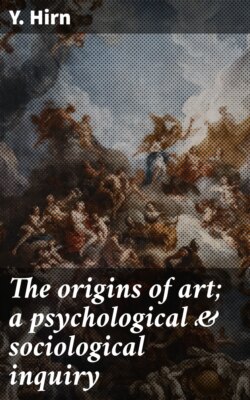Читать книгу The origins of art; a psychological & sociological inquiry - Y. Hirn - Страница 3
На сайте Литреса книга снята с продажи.
PREFACE
ОглавлениеTable of Contents
The aim and scope of this book is sufficiently indicated by its title. I have endeavoured throughout to restrict my attention to questions connected with the origins of art. Points of history and criticism have been touched upon only in so far as they appeared to contribute towards the elucidation of this purely psychological and sociological problem. In order to save space as well as to spare the reader’s attention, the descriptive parts have been concentrated as much as possible. As a rule, only one ethnological example, which has been selected as typical, is described in the text, while the corroborating examples are represented by references in the footnotes. And even of these references only such are adduced as have been considered especially significant. Only in one matter have I aimed at completeness, viz. that of reference to authors from whom I have borrowed facts or observations. And whenever in earlier literature I have found theories which have appeared similar to the views advanced in this book, these similarities have been pointed out in the footnotes.
There is one point, however, to which the reader’s attention should be called in this Preface. When treating of the art-impulse I have—especially in the tenth chapter—mentioned in the footnotes some modern writers on æsthetic, who, although starting from different assumptions, have arrived at a conception of art which in many points may be compared to the one advanced in this book. This comparison, however, has not been carried out in the text. Considerations of space account for this omission; but it has a further ground in the circumstances under which the present work has originated. A part of it, containing the examination of feeling and its expression, and the chapter on “Animal Display,” was published in Swedish as early as 1896[1]—that is, before the above-mentioned authors had made their theories known. This is not mentioned in order to raise any futile questions of priority, but only as a justification of the way in which my conclusions have been presented.
It has appeared to me that the continuity of the argument could not but have been broken if, instead of proceeding from my original starting-point, I had based my conclusions upon a critical examination of modern æsthetic doctrines. And I trust that the differences between the thesis of this book and other emotionalistic explanations will appear with sufficient clearness to the attentive reader even if they have not been expressly pointed out in the text.
There are, no doubt, many points, a fuller treatment of which might have been to the advantage of the book. The force of circumstances has compelled me to aim at brevity before anything. But even if it had been possible to give this study a far greater comprehensiveness, the difficulties of expressing myself in a foreign tongue would have withheld me from any avoidable amplification. I have constantly been conscious of my audacity in appearing before the English public without sufficiently mastering the English language, and I have been anxious not to make my offence greater by any number of pages than it already is.
That it has been possible at all to publish this research in English is only a result of the kind assistance which I have received from my English friends. I am indebted to Mr. G. G. Berry in Oxford, and Mr. Leonard Pomeroy in London, who have revised parts of the manuscript. And I am further indebted to my publishers for procuring me the assistance of Mr. Stephen Gwynn in preparing the book for the press. He has helped me to avoid needlessly technical expressions, and in other ways has given the work a more readable style. But he has not restricted himself to these emendations. He has assisted me with valuable suggestions as well as with information. The improvement which the work has derived from his collaboration can be sufficiently appreciated only by its author.
In purely scientific matters I have benefited much from discussions with students of psychology and sociology in my own country as well as in England. My thanks are due to all of them, but especially to my old friends, Dr. Edward Westermarck and Dr. Richard Wallaschek.
The “List of Authorities quoted” and the Indexes have been compiled by my wife. This is, however, only the least important part of the assistance which throughout the book has been rendered to me by the constant collaborator in all my researches.
Y. H.
Helsingfors, August 1900.
